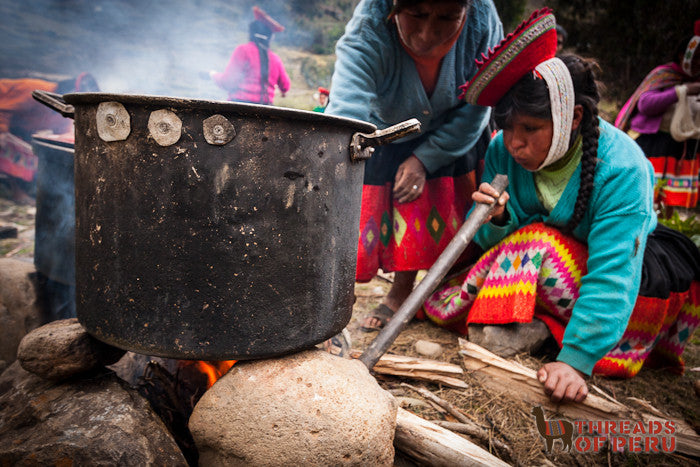
Last week I talked about getting to our weaving community of Rumira for a dye workshop. This week I take a look at the actual dyeing process.
We walked down a muddy hill and onto a level area near a shallow stream. Here women dressed in traditional Andean clothes tended fires and filled big pots with water from the icy river. A few introductions were made but, with a long day of work ahead, there wasn’t much time for formalities.

As the fires burned higher, the open field that served as the workshop’s classroom filled with thick and bitter smoke from oily eucalyptus wood still green and only cut that morning. Most of the Westerners backed away, rubbing their eyes and coughing. The Peruvian women remained.

The women relied on simple but innovative techniques for keeping the fires going. Instead of fanning the flames, the women used pieces of metal pipe — about two feet long — to blow directly on the coals. It looked simple but it really took a lot of skill. At least one of the Threads’ team members tried it and ended up with a mouthful of smoke. When more wood was needed for the flames, the women walked to the nearest tree and liberated a branch. This was then split with a heavy-headed axe and thrown onto the coals.

The fires were built between stones about the size of a football which served as supports for the big pots where the wool would be dyed. Heating the water is an important part of the dyeing process as it helps to extract the color from the natural herbs and other ingredients. However, on this cold and drippy morning, it took some of the pots more than an hour before they were ready for wool.

The wool the women used at the workshops came from both alpacas and sheep. Most of it was from their own flocks but due to shortages, some machine spun wool was also purchased. Once this is dyed, the women will pull apart the threads and re-spin them by hand because many of their looms won’t work with the finer machined wool.

When the water was hot, natural dyes were added followed by the wool which had been washed in the river to rid it of any oils that could keep the dyes from taking. To get a deep red color, handfuls of crushed chochineal — an insect native to Latin America — were stirred into steaming water. For yellow, bags of Qolle flowers were added to the water, and green was achieved by boiling Ch’illca leaves with the wool. Other colors like purple and orange were created by using the same ingredients as red and yellow but with the addition of additives like lemon salt.

Wool remains soaking in the water and dye for a set amount of time depending on the desired color and shade. Once the women were satisfied with the tones their wool had taken on, they pulled the steamy bundle from the pot and put it in a plastic tub. When it had cooled further, they took the wool to the river. In the water the women scrubbed the wool and washed it with soap.

The dyed and washed wool was then hung to dry. The day was rainy and dry surfaces were in high demand. Bright bundles of wool were soon covering many of the rocks and bushes near the workshop.

When the time came for our departure, the women were still hard at work over the fires and in the river. Work paused for a moment as the women brought out some of their weaving to demonstrate the final product. The soggy tangles of wool that hung all around us would someday wind up as these carefully crafted scarves, bracelets, and hats.

We said our goodbyes and got into the van. An hour of bumpy roads would take us back to Ollantaytambo. As we pulled out of the village, I could still see the smoke floating up from the riverside. We were going home and the women were going back to work.
Next week look for an article on the people of Rumira.

